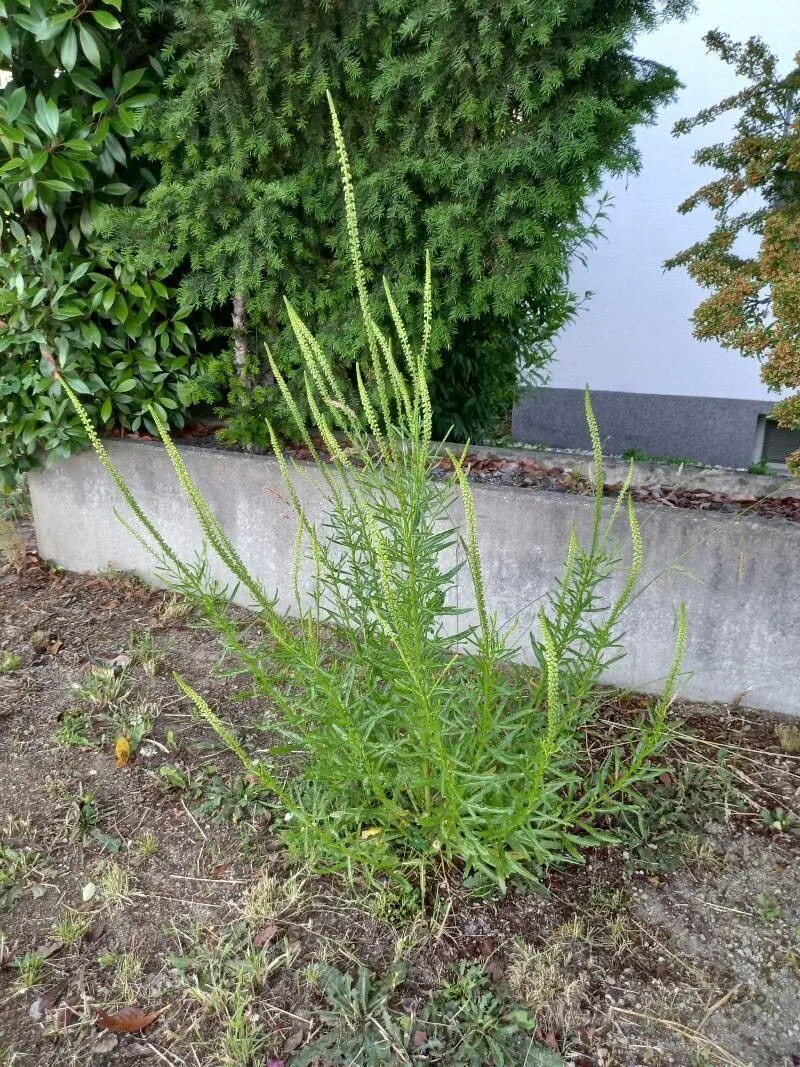
Author: L.
Bibliography: Sp. Pl.: 448 (1753)
Year: 1753
Status: accepted
Rank: species
Genus: Reseda
Vegetable: False
Observations: Macaronesia, N. Africa, Europe to C. Asia and Pakistan
Dyer’s rocket, scientifically known as Reseda luteola, is a plant that has garnered interest historically and contemporarily for various reasons. Described initially in 1753 by the renowned botanist Carl Linnaeus, as noted in his seminal work “Species Plantarum,” this plant has a rich history and wide distribution.
Belonging to the family Resedaceae, Dyer’s rocket is native to regions encompassing Macaronesia, North Africa, Europe, Central Asia, and Pakistan. This extensive geographical span is a testament to its adaptability to different environments.
One of the notable aspects of Dyer’s rocket is its historical use as a natural dye. The plant’s yellow flowers were a vital source of a vibrant yellow dye, which was widely used in textile industries before the advent of synthetic dyes. This dye, known historically as “weld,” was prized for its lightfastness and brilliance.
Apart from its utility in dyeing, Reseda luteola also has ecological importance. It is a biennial or perennial plant that thrives in various soil types, often found in disturbed soils, such as roadsides and waste places. Its growth cycle and ability to colonize such areas make it an important species for soil stabilization and reclamation projects.
Moreover, the Dyer’s rocket plays a role in supporting biodiversity. It attracts various pollinators, including bees and butterflies, thereby contributing to the pollination of crops and wild plants in its vicinity.
In summary, Reseda luteola or Dyer’s rocket holds a significant place not only due to its historical economic importance as a dye plant but also because of its botanical and ecological contributions across a broad geographic range.
Lit: dažinė razeta
Dan: farve-reseda
Deu: färber-resede, färber-wau, färberkraut, färberwau
Spa: gualda, gabarro
Pol: rezeda żółtawa
Eng: weld, dyer’s rocket, dyer’s-rocket, gualda, wild mignonette, dyer’s weld
Nob: fargereseda
Nno: fargereseda
Swe: färgreseda, värireseda, vau
Por: gauda
Fra: guade, réséda des teinturiers, réséda jaunâtre, gaude, herbe à jaunir
Lav: iedzelten
Ces: rýt barvířský
Fin: värireseda
Est: värvireseeda
Nld: wouw
Sme: ivdnereseda
Cym: cynffon titw, melen-gu, melengu, melyngu
En: Dyer’s rocket, Weld, Wild mignonette, Dyer’s weed, Yellow weed, Dyer’s-rocket, Gualda, Dyer’s weld, Dyer’s Mignonette
Ar: بقم (بَْقم، بَقَّم), بليحه (بِليحه)، خزامه (خٌزامه), خزامه (خُزامه، خَزامه، خِزامه)
Ca: Disciplinant, Galda
Cs: Rýt barvířský
Da: Farve-reseda
Nl: Wouw
Et: Värvireseeda
Fi: Värireseda
Fr: Guade, Réséda des teinturiers, Réséda jaunâtre, Gaude, Herbe à jaunir, Herbe jaune, Mignonette jaunâtre
De: Färberkraut, Färberwau, Färber-Resede, Färber-Wau, Färber-Reseda
He: רכפת הצבעים
It: Erba-guada, Reseda biondella
Lv: Iedzelten
Lt: Dažinė razeta
Se: Ivdnereseda
Nb: Fargereseda
Nn: Fargereseda
Pl: Rezeda żółtawa
Pt: Gauda
Sk: Rezeda žltá
Es: Gualda, Gabarro
Sv: Färgreseda, Värireseda, Vau
Cy: Cynffon Titw, Melen-Gu, Melengu, Melyngu
© copyright of the Board of Trustees of the Royal Botanic Gardens, Kew.
© copyright of the Board of Trustees of the Royal Botanic Gardens, Kew.
© copyright of the Board of Trustees of the Royal Botanic Gardens, Kew.
Taken Jul 2, 2021 by Manū (cc-by-sa)
Taken Jun 6, 2022 by Kai Best (cc-by-sa)
Taken Jul 17, 2019 by Reynold Chollet (cc-by-sa)
Taken Jun 20, 2020 by Rik Michiels (cc-by-sa)
Taken Jun 25, 2019 by Luis Corcuera (cc-by-sa)
Taken Jul 19, 2021 by Miguel A. C. (cc-by-sa)
Taken Jun 6, 2022 by Kai Best (cc-by-sa)
Taken May 24, 2021 by Nils Kieffer (cc-by-sa)
Taken Jul 2, 2021 by Manū (cc-by-sa)
Taken May 18, 2022 by Kai Best (cc-by-sa)
Taken Jul 19, 2021 by Miguel A. C. (cc-by-sa)
Taken May 15, 2020 by José Manuel Martín (cc-by-sa)
Taken Jun 12, 2020 by sg (cc-by-sa)
Taken Jun 6, 2022 by Kai Best (cc-by-sa)
Taken May 18, 2022 by Kai Best (cc-by-sa)
Taken Jul 22, 2021 by Steve Orridge (cc-by-sa)
Taken Jul 21, 2020 by rubus (cc-by-sa)
Taken Dec 23, 2011 by Tela Botanica − Yoan MARTIN (cc-by-sa)
Taken Oct 22, 2022 by Kai Best (cc-by-sa)
Taken Jul 19, 2021 by Miguel A. C. (cc-by-sa)
Taken Oct 14, 2014 by Tela Botanica − Liliane Roubaudi (cc-by-sa)
Taken Aug 7, 2021 by Renaud Brochiero (cc-by-sa)
Taken Oct 14, 2014 by Tela Botanica − Liliane Roubaudi (cc-by-sa)
Taken Dec 23, 2011 by Tela Botanica − Yoan MARTIN (cc-by-sa)
Taken Oct 14, 2014 by Tela Botanica − Liliane Roubaudi (cc-by-sa)
Taken Jul 19, 2020 by Chris Georges (cc-by-sa)
Taken May 25, 2015 by Tela Botanica − Yoan MARTIN (cc-by-sa)
Taken Oct 14, 2014 by Tela Botanica − Liliane Roubaudi (cc-by-sa)
Taken May 25, 2015 by Tela Botanica − Yoan MARTIN (cc-by-sa)
Taken May 9, 2022 by Gaël Covain (cc-by-sa)
Growth habit: Forb/herb
Ph maximum: 7.5
Ph minimum: 7.0
Light: 8
Atmospheric humidity: 4
Soil nutriments: 6
Family: Myrtaceae Author: (F.Muell.) K.D.Hill & L.A.S.Johnson Bibliography: Telopea 6: 402 (1995) Year: 1995 Status:…
Family: Rubiaceae Author: Pierre ex A.Froehner Bibliography: Notizbl. Bot. Gart. Berlin-Dahlem 1: 237 (1897) Year:…
Family: Sapindaceae Author: Koidz. Bibliography: J. Coll. Sci. Imp. Univ. Tokyo 32(1): 38 (1911) Year:…
Family: Asteraceae Author: A.Gray Bibliography: Pacif. Railr. Rep.: 107 (1857) Year: 1857 Status: accepted Rank:…
Family: Fabaceae Author: Medik. Bibliography: Vorles. Churpfälz. Phys.-Ökon. Ges. 2: 398 (1787) Year: 1787 Status:…
Family: Aspleniaceae Author: (Cav.) Alston Bibliography: Bull. Misc. Inform. Kew 1932: 309 (1932) Year: 1932…